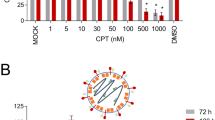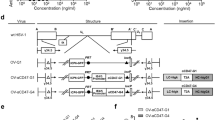Abstract
Oncolytic measles virus (MV) strains have demonstrated broad spectrum preclinical anti-tumor efficacy, including breast cancer. Aurora A kinase controls mitotic spindle formation and has a critical role in malignant transformation. We hypothesized that the Aurora A kinase inhibitor MLN8237 (alisertib) can increase MV oncolytic effect and efficacy by causing mitotic arrest. Alisertib enhanced MV oncolysis in vitro and significantly improved outcome in vivo against breast cancer xenografts. In a disseminated MDA-231-lu-P4 lung metastatic model, the MV/alisertib combination treatment markedly increased median survival to 82.5 days with 20% of the animals being long-term survivors versus 48 days median survival for the control animals. Similarly, in a pleural effusion model of advanced breast cancer, the MV/alisertib combination significantly improved outcome with a 74.5 day median survival versus the single agent groups (57 and 40 days, respectively). Increased viral gene expression and IL-24 upregulation were demonstrated, representing possible mechanisms for the observed increase in anti-tumor effect. Inhibiting Aurora A kinase with alisertib represents a novel approach to enhance MV-mediated oncolysis and antitumor effect. Both oncolytic MV strains and alisertib are currently tested in clinical trials, this study therefore provides the basis for translational applications of this combinatorial strategy in the treatment of patients with advanced breast cancer.
This is a preview of subscription content, access via your institution
Access options
Subscribe to this journal
Receive 12 print issues and online access
$259.00 per year
only $21.58 per issue
Buy this article
- Purchase on Springer Link
- Instant access to full article PDF
Prices may be subject to local taxes which are calculated during checkout






Similar content being viewed by others
References
Siegel R, Naishadham D, Jemal A . Cancer statistics, 2012. CA Cancer J Clin 2012; 62: 10–29.
Bell J, McFadden G . Viruses for tumor therapy. Cell Host Microbe 2014; 15: 260–265.
Iankov ID, Msaouel P, Allen C, Federspiel MJ, Bulur PA, Dietz AB et al. Demonstration of anti-tumor activity of oncolytic measles virus strains in a malignant pleural effusion breast cancer model. Breast Cancer Res Treat 2010; 122: 745–754.
Iankov ID, Allen C, Federspiel MJ, Myers RM, Peng KW, Ingle JN et al. Expression of immunomodulatory neutrophil-activating protein of Helicobacter pylori enhances the antitumor activity of oncolytic measles virus. Mol Ther 2012; 20: 1139–1147.
McDonald CJ, Erlichman C, Ingle JN, Rosales GA, Allen C, Greiner SM et al. A measles virus vaccine strain derivative as a novel oncolytic agent against breast cancer. Breast Cancer Res Treat 2006; 99: 177–184.
Griffin D . Measles virus. In: Knipe DM, Howley PM (eds). Fields Virology, 4th edn. Lippincott, Williams & Wilkins: Philadelphia, PA, USA, 2001, pp 1401–1441.
Bjorge L, Hakulinen J, Wahlstrom T, Matre R, Meri S . Complement-regulatory proteins in ovarian malignancies. Int J Cancer 1997; 70: 14–25.
Muhlebach MD, Mateo M, Sinn PL, Prufer S, Uhlig KM, Leonard VH et al. Adherens junction protein nectin-4 is the epithelial receptor for measles virus. Nature 2011; 480: 530–533.
Tatsuo H, Ono N, Tanaka K, Yanagi Y . SLAM (CDw150) is a cellular receptor for measles virus. Nature 2000; 406: 893–897.
Amedei A, Cappon A, Codolo G, Cabrelle A, Polenghi A, Benagiano M et al. The neutrophil-activating protein of Helicobacter pylori promotes Th1 immune responses. J Clin Invest 2006; 116: 1092–1101.
Evans DJ Jr, Evans DG, Takemura T, Nakano H, Lampert HC, Graham DY et al. Characterization of a Helicobacter pylori neutrophil-activating protein. Infect Immun 1995; 63: 2213–2220.
Ramachandran M, Jin C, Yu D, Eriksson F, Essand M . Vector-encoded Helicobacter pylori neutrophil-activating protein promotes maturation of dendritic cells with Th1 polarization and improved migration. J Immunol 2014; 193: 2287–2296.
Nikonova AS, Astsaturov I, Serebriiskii IG, Dunbrack RL Jr, Golemis EA . Aurora A kinase (AURKA) in normal and pathological cell division. Cell Mol Life Sci 2013; 70: 661–687.
Van Horn RD, Chu S, Fan L, Yin T, Du J, Beckmann R et al. Cdk1 activity is required for mitotic activation of aurora A during G2/M transition of human cells. J Biol Chem 2010; 285: 21849–21857.
D'Assoro AB, Liu T, Quatraro C, Amato A, Opyrchal M, Leontovich A et al. The mitotic kinase Aurora—a promotes distant metastases by inducing epithelial-to-mesenchymal transition in ERalpha(+) breast cancer cells. Oncogene 2014; 33: 599–610.
Nadler Y, Camp RL, Schwartz C, Rimm DL, Kluger HM, Kluger Y . Expression of Aurora A (but not Aurora B) is predictive of survival in breast cancer. Clin Cancer Res 2008; 14: 4455–4462.
Wang X, Zhou YX, Qiao W, Tominaga Y, Ouchi M, Ouchi T et al. Overexpression of aurora kinase A in mouse mammary epithelium induces genetic instability preceding mammary tumor formation. Oncogene 2006; 25: 7148–7158.
Katayama H, Sen S . Aurora kinase inhibitors as anticancer molecules. Biochim Biophys Acta 2010; 1799: 829–839.
Cervantes A, Elez E, Roda D, Ecsedy J, Macarulla T, Venkatakrishnan K et al. Phase I pharmacokinetic/pharmacodynamic study of MLN8237, an investigational, oral, selective aurora a kinase inhibitor, in patients with advanced solid tumors. Clin Cancer Res 2012; 18: 4764–4774.
Dees EC, Cohen RB, von Mehren M, Stinchcombe TE, Liu H, Venkatakrishnan K et al. Phase I study of aurora A kinase inhibitor MLN8237 in advanced solid tumors: safety, pharmacokinetics, pharmacodynamics, and bioavailability of two oral formulations. Clin Cancer Res 2012; 18: 4775–4784.
Friedberg JW, Mahadevan D, Cebula E, Persky D, Lossos I, Agarwal AB et al. Phase II study of alisertib, a selective Aurora A kinase inhibitor, in relapsed and refractory aggressive B- and T-cell non-Hodgkin lymphomas. J Clin Oncol 2014; 32: 44–50.
Matulonis UA, Sharma S, Ghamande S, Gordon MS, Del Prete SA, Ray-Coquard I et al. Phase II study of MLN8237 (alisertib), an investigational Aurora A kinase inhibitor, in patients with platinum-resistant or -refractory epithelial ovarian, fallopian tube, or primary peritoneal carcinoma. Gynecol Oncol 2012; 127: 63–69.
Duprex WP, McQuaid S, Hangartner L, Billeter MA, Rima BK . Observation of measles virus cell-to-cell spread in astrocytoma cells by using a green fluorescent protein-expressing recombinant virus. J Virol 1999; 73: 9568–9575.
Iankov ID, Hillestad ML, Dietz AB, Russell SJ, Galanis E . Converting tumor-specific markers into reporters of oncolytic virus infection. Mol Ther 2009; 17: 1395–1403.
Iankov ID, Haralambieva IH, Galanis E . Immunogenicity of attenuated measles virus engineered to express Helicobacter pylori neutrophil-activating protein. Vaccine 2011; 29: 1710–1720.
Haralambieva IH, Ovsyannikova IG, Vierkant RA, Poland GA . Development of a novel efficient fluorescence-based plaque reduction microneutralization assay for measles virus immunity. Clin Vaccine Immunol 2008; 15: 1054–1059.
Leontovich AA, Salisbury JL, Veroux M, Tallarita T, Billadeau D, McCubrey J et al. Inhibition of Cdk2 activity decreases Aurora-A kinase centrosomal localization and prevents centrosome amplification in breast cancer cells. Oncol Rep 2013; 29: 1785–1788.
Zhu W, Wei L, Zhang H, Chen J, Qin X . Oncolytic adenovirus armed with IL-24 inhibits the growth of breast cancer in vitro and in vivo. J Exp Clin Cancer Res 2012; 31: 51.
Fielding AK . Measles as a potential oncolytic virus. Rev Med Virol 2005; 15: 135–142.
Falchook G, Kurzrock R, Gouw L, Hong D, McGregor KA, Zhou X et al. Investigational Aurora A kinase inhibitor alisertib (MLN8237) as an enteric-coated tablet formulation in non-hematologic malignancies: phase 1 dose-escalation study. Invest New Drugs 2014; 32: 1181–1187.
Macarulla T, Cervantes A, Elez E, Rodriguez-Braun E, Baselga J, Rosello S et al. Phase I study of the selective Aurora A kinase inhibitor MLN8054 in patients with advanced solid tumors: safety, pharmacokinetics, and pharmacodynamics. Mol Cancer Ther 2010; 9: 2844–2852.
Brewer Savannah KJ, Demicco EG, Lusby K, Ghadimi MP, Belousov R, Young E et al. Dual targeting of mTOR and aurora-A kinase for the treatment of uterine Leiomyosarcoma. Clin Cancer Res 2012; 18: 4633–4645.
Fiskus W, Hembruff SL, Rao R, Sharma P, Balusu R, Venkannagari S et al. Co-treatment with vorinostat synergistically enhances activity of Aurora kinase inhibitor against human breast cancer cells. Breast Cancer Res Treat 2012; 135: 433–444.
Sehdev V, Peng D, Soutto M, Washington MK, Revetta F, Ecsedy J et al. The aurora kinase A inhibitor MLN8237 enhances cisplatin-induced cell death in esophageal adenocarcinoma cells. Mol Cancer Ther 2012; 11: 763–774.
Palani S, Patel M, Huck J, Zhang M, Balani SK, Yang J et al. Preclinical pharmacokinetic/pharmacodynamic/efficacy relationships for alisertib, an investigational small-molecule inhibitor of Aurora A kinase. Cancer Chemother Pharmacol 2013; 72: 1255–1264.
Heinemann L, Simpson GR, Annels NE, Vile R, Melcher A, Prestwich R et al. The effect of cell cycle synchronization on tumor sensitivity to reovirus oncolysis. Mol Ther 2010; 18: 2085–2093.
Libertini S, Abagnale A, Passaro C, Botta G, Barbato S, Chieffi P et al. AZD1152 negatively affects the growth of anaplastic thyroid carcinoma cells and enhances the effects of oncolytic virus dl922-947. Endocr Relat Cancer 2011; 18: 129–141.
Zeng WG, Li JJ, Hu P, Lei L, Wang JN, Liu RB . An oncolytic herpes simplex virus vector, G47Delta, synergizes with paclitaxel in the treatment of breast cancer. Oncol Rep 2013; 29: 2355–2361.
Frewer NC, Ye L, Sun PH, Owen S, Ji K, Frewer KA et al. Potential implication of IL-24 in lymphangiogenesis of human breast cancer. Int J Mol Med 2013; 31: 1097–1104.
Zheng M, Bocangel D, Doneske B, Mhashilkar A, Ramesh R, Hunt KK et al. Human interleukin 24 (MDA-7/IL-24) protein kills breast cancer cells via the IL-20 receptor and is antagonized by IL-10. Cancer Immunol Immunother 2007; 56: 205–215.
Bhutia SK, Das SK, Azab B, Menezes ME, Dent P, Wang XY et al. Targeting breast cancer-initiating/stem cells with melanoma differentiation-associated gene-7/interleukin-24. Int J Cancer 2013; 133: 2726–2736.
Galanis E, Atherton PJ, Maurer MJ, Knutson KL, Dowdy SC, Cliby WA et al. Oncolytic measles virus expressing the sodium iodide symporter to treat drug-resistant ovarian cancer. Cancer Res 2015; 75: 22–30.
Russell SJ, Federspiel MJ, Peng KW, Tong C, Dingli D, Morice WG et al. Remission of disseminated cancer after systemic oncolytic virotherapy. Mayo Clin Proc 2014; 89: 926–933.
Acknowledgements
We wish to thank Dr Jeffery A. Ecsedy from Oncology Translational Medicine, Takeda Pharmaceuticals International Co., Cambridge, Massachusetts for his input about MLN-8237 drug formulation and dosing. This work was supported by NIH Grants P50CA 116201, R01CA 136547, and R01CA 154348, an Atwater Foundation Grant, and the Nan Sawyer Fund.
Author information
Authors and Affiliations
Corresponding author
Ethics declarations
Competing interests
The authors declare no conflict of interest.
Rights and permissions
About this article
Cite this article
Iankov, I., Kurokawa, C., D'Assoro, A. et al. Inhibition of the Aurora A kinase augments the anti-tumor efficacy of oncolytic measles virotherapy. Cancer Gene Ther 22, 438–444 (2015). https://doi.org/10.1038/cgt.2015.36
Received:
Revised:
Accepted:
Published:
Issue Date:
DOI: https://doi.org/10.1038/cgt.2015.36
This article is cited by
-
Oncolytic virotherapy: basic principles, recent advances and future directions
Signal Transduction and Targeted Therapy (2023)
-
Improving cancer immunotherapy by rationally combining oncolytic virus with modulators targeting key signaling pathways
Molecular Cancer (2022)
-
NOTCH3 expression is linked to breast cancer seeding and distant metastasis
Breast Cancer Research (2018)



